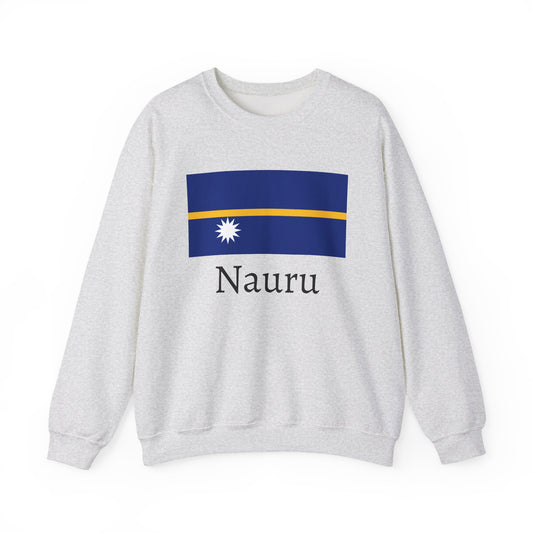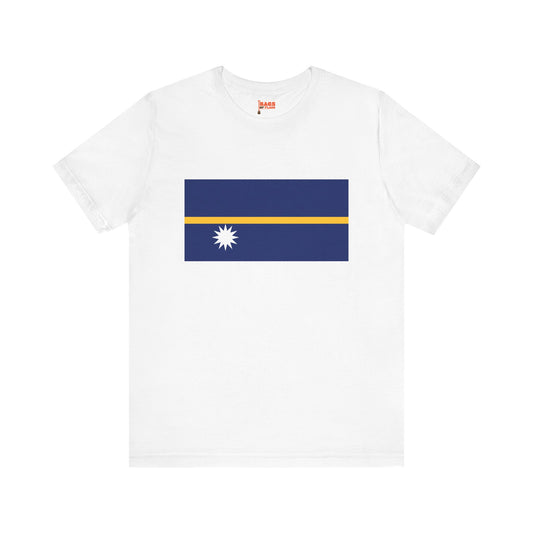-
Nauru Sweatshirt
Regular price $34.15 USDRegular priceUnit price / per -
Nauru Flag Sweatshirt
Regular price $34.15 USDRegular priceUnit price / per -
Nauru Pillow
Regular price $22.65 USDRegular priceUnit price / per -
Nauru Backpack
Regular price $59.79 USDRegular priceUnit price / per -
Nauru Leather Patch Hat
Regular price $18.85 USDRegular priceUnit price / per -
Nauru Trucker Cap
Regular price $14.90 USDRegular priceUnit price / per -
Nauru T-shirts
Regular price $22.79 USDRegular priceUnit price / per -
Nauru Hoodies
Regular price $34.40 USDRegular priceUnit price / per -
Nauru Flag Hoodies
Regular price $34.40 USDRegular priceUnit price / per -
Nauru Flag on T-shirt
Regular price $22.79 USDRegular priceUnit price / per
Collection: Nauru
The Nauru flag, also known as the flag of Nauru, symbolizes pride and identity for the people of this small island nation in the Pacific Ocean. Its unique design and colors hold deep historical and cultural significance. We will explore the traditions, controversies, and fun facts surrounding the Nauru flag.
Overview of the Nauru Flag's Design and Colors

The flag of Nauru showcases a striking and symbolic design that captures the essence of the island nation. A vivid blue background envelopes the flag, symbolizing the expansive Pacific Ocean that surrounds Nauru. Cutting across this serene blue is a narrow horizontal yellow stripe, representing the Equator, acknowledging Nauru's geographical placement just south of this global divider. Anchored in the canton, a white, twelve-pointed star emerges as a focal point against the blue backdrop. Each end of the star is a tribute to one of the twelve indigenous tribes constituting Nauruan society's fabric. The stark white of the star stands out against the blue, serving as a beacon of unity and diversity, embodying the strength and resilience of the Nauruan people. Together, these elements combine to form a flag that is not only visually distinctive but deeply rooted in the symbolism of its natural environment and cultural heritage.
Historical Context Surrounding the Nauru Flag
The flag of Nauru was inaugurated into the nation's identity on January 31, 1968, coinciding with the island's declaration of independence from Australian trusteeship. This historic event marked Nauru's emergence as a sovereign state, with the flag as a potent symbol of its newfound autonomy. The decision to adopt a specific flag design followed a country-wide competition that encouraged participation from Nauruans, fostering a sense of national unity and collective creativity.
The chosen design reflected Nauru's cultural and environmental uniqueness, distilling its essence into a visually distinct and meaningful emblem. This period in Nauru's history was a transformative time, with the flag’s adoption symbolizing a break from colonial rule and the beginning of self-determination. The flag has since stood as a testament to Nauru's journey towards independence and its aspirations as a nation, encapsulating its people's struggles and achievements.
Symbolism Embodied in the Flag's Design

The flag of Nauru intricately weaves together elements that reflect the island's geography, culture, and social structure. Central to its design is the vast blue field, a vivid representation of the ocean that has sustained and isolated Nauru for millennia. This oceanic backdrop sets the stage for the symbolic yellow stripe, a symbol of the Equator. Nauru's proximity to this global landmark is a defining feature of its tropical identity, influencing both its climate and way of life. This stripe acts as a geographic marker and a unity line, connecting Nauru to the broader world along the equatorial belt.
At the heart of the flag's symbolism is the white twelve-pointed star. Each point stands for one of the twelve original tribes of Nauru, a permanent reminder of the island's indigenous roots and the importance of community and heritage. The star's placement on the blue field, offset to the left, signifies Nauru's position just south of the Equator. The color white was chosen for the star to symbolize peace and optimism, contrasting sharply with the blue and yellow to draw attention to these underlying themes of unity and identity.
Through these carefully chosen symbols and colors, the flag narrates a story of Nauru’s enduring spirit, its connection to the natural world, and its society's cohesiveness despite past and present challenges.
Current Relevance of the Nauru Flag
Today, the Nauru flag remains a significant emblem, visible at various events, from governmental ceremonies to international sports competitions, symbolizing national unity and pride. It embodies the aspirations and achievements of the Nauruan people, flying high on occasions of national importance such as Independence Day and other celebrated holidays. Moreover, its presence in educational settings, often part of the curriculum, educates the younger generation about their heritage and the importance of national identity.
In recent years, the flag has also been central in diplomatic missions and visits, representing Nauru globally, fostering international relationships, and showcasing the nation’s sovereignty. Amidst these traditional uses, the flag is at the heart of contemporary discussions and debates, reflecting the nation's evolving role in regional and global affairs. Its depiction during events related to Nauru’s involvement in international agreements and partnerships highlights the flag's role as a symbol of the nation's ongoing journey in the 21st century, illustrating its continued relevance in representing the values, hopes, and the indomitable spirit of Nauru and its people.
Additional Facts and Unique Protocols Associated with the Nauru Flag
While the Nauru flag symbolizes the nation's pride and identity, there are several intriguing protocols and lesser-known facts about its handling and display. It's essential that the flag is always respected, which includes ensuring it never makes contact with the ground - a sign of utmost respect and dignity towards the nation's emblem. Additionally, it is considered improper to display the flag in a position where it could be seen as upside down, a guideline that reinforces the importance of the flag's orientation and the respect it commands.
One of the more unique aspects of the Nauru flag is its inclusion of a twelve-pointed star, a rare feature among national flags. This distinct design choice not only sets it apart visually on the international stage but also reinforces the deep symbolism embedded within the flag, with each point representing one of Nauru's twelve indigenous tribes.
Another interesting note is the specific conditions under which the flag is flown at half-mast. This act is reserved for periods of national mourning, serving as a powerful symbol of respect, remembrance, and solidarity during times of collective grief.
These protocols and facts underscore the deep respect Nauruans hold for their flag, highlighting its significance beyond a mere national symbol to an emblem woven into the fabric of the nation's identity and values.






















